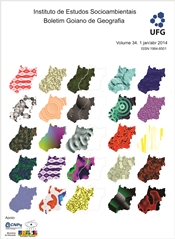AGRO-PASTORAL ACTIVITIES EFFECT ON THE PHYSICAL AND CHEMICAL ATTRIBUTES OF THREE CLASSES OF SOILS OF A WATERSHED IN THE BRAZILIAN SEMIARID - DOI 10.5216/bgg.v34i1.28645
DOI:
https://doi.org/10.5216/bgg.v34i1.28645Abstract
The soils of the Brazilian Semiarid region are commonly shallow and stony. Also, due to climatic conditions that alternate between droughts and torrential rains, its development is often incipient. In addition, the use is often at odds with the existing potential. The sum of these factors contributes to the existence of soils with absence
of several attributes that protect it from erosion. The area under consideration here was the Serra Branca river basin, located in western Cariri of Paraíba. The work consisted of an exploratory study of the predominant soil types (Luvisol, Vertisol and Neosoil Regolithic) and the mapping of the area, based on the use of GIS and existing information. The soil characterization aimed the knowledge of some properties related to erosive processes (compaction, particle size, density, infiltration, organic matter and oxygen incorporated). The results showed the absence of clay material, a high percentage of compaction, reduced infiltration rates and low levels of organic matter and organic oxygen incorporated. This shows that not only the climatic conditions therein contribute to land degradation, but also the use and soil management contribute decisively to the occurrence of erosion, affecting the environmental balance of the area.
Key words: soil compaction, impacts of use and management on soils, watershed.
Downloads
Downloads
Published
How to Cite
Issue
Section
License
Authors will not receive any payment for publishing their work in Boletim Goiano de Geografia. Therefore, they must grant all rights to the journal. However, they are entirely and exclusively responsible for the published contents, and editors are free to make corrections or adjustments to texts in conformity with publication guidelines.







